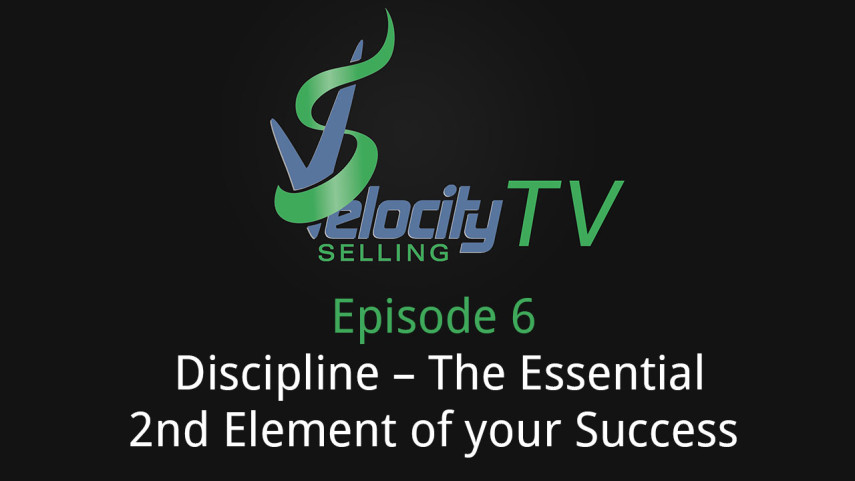We begin this episode of Velocity Selling TV with CEO, Matthew Whyatt and founder, Bob Urichuck discussing the characteristics of successful sales people, and what it takes to realize within whether or not you have the characteristics that are required to gain success.
Matthew: Hi, Matthew Whyatt here, CEO of Velocity Selling, uh, based here on the Gold Coast of Australia, and we’ve got Bob Urichuck, the founder of Velocity Selling up in Ottawa, Canada. Welcome, Bob.
Bob: Well hey, Matthew, and thanks for having me once more.
Matthew: Hey, Bob, uh, let’s just dive straight into it. What do you think are the characteristics of successful sales people?
Bob: Well that’s a good question, and really that’s the topic of our discussion today, but before I answer that question for you, Matthew, I’m going to have to engage you in a conversation. Is it ok if I ask you some questions?
Matthew: Sure. –laughing-
Bob: Ok. But just in case people have missed this, let me give a little background. You started this whole process by asking me, uh, you know, what’s non-traditional selling. Why do you say Velocity Selling is non-traditional? We explained that to you how it’s the difference, it’s not traditional methods and techniques. We also shared with you how education is different and how we’re non-traditional in the learning process, and how we engage our audience the same way we need to engage buyers to buy. So from non-traditional, we went into, I believe you asked me about the foundation of success. And again, I helped you discover, because it was a self-discovery process, what those, uh, you gave me three or four words that got you to the success that you’re at. You also concluded that attitude was that foundation, and we both agreed. And then we shared with our listeners how attitude led to one hundred percent performance. Then the following episode, if I recall, we shared discipline. And, and, I know I’m going through a lot here, but I’m going to show you how it all comes together in this particular, this episode and the next episode. We get into discipline. Uh, when you put attitude and discipline together you get two hundred percent performance. Now, let’s take a look at attitude and discipline and how they impact characteristics of successful sales people. Because whole, all this is a process. Now, Matthew, you’ve been in sales for a long time. You’ve been in the, all kinds of, uh, sales situations. You’ve seen top-selling people. Let’s, I want you to name out, come with, come to me with as many words as you can of, what would you say are the top characteristics of successful sales people?
Matthew: Well, I, I absolutely am just thinking about my sales rooms that I’ve run in the past, we’re talking about, uh, salespeople with, uh, with great product knowledge, uh great attitude, certainly very disciplined, uh great communicators, excellent listeners, uh and uh, things like that.
Bob: Ok, so they’re goal-oriented, they’re self-motivated, um, they engage people, you know, uh, they’re good listeners, they’re, um, the good communicators, they’re professional, they’re polite. There’s so many words we could use, and I’m sure if we engaged our listeners in this, we would have thousands of words that would come across.
Matthew: Sure.
Bob: Got it? Now—
Matthew: Absolutely.
Bob: —When, and, and that’s really what it’s all about. So what I would like people to do, and, and it’s an exercise again, if we listed all these characteristics of top sales people, I want, then, people to reflect on themselves. You know, communicator, am I a good communicator? Yes or no? Give yourself a check mark if you are. If you’re not a good communicator, leave it blank. The idea here is for you to discover for yourself, when you compare yourself to the characteristics of other successful sales people, do you have those characteristics or not? And if you don’t have them, what can you do? Actually, you could learn them; you could master them. The first thing we need to do is, where are our weaknesses, where are our strengths? This exercise helps us understand where our strengths lie and where our weaknesses lie and where we could use areas of improvement. Then we could specif- We could get into certain modules in our training that could help people learn those specific components: those characteristics. Though, again, it all boils down to attitude. And attitude is under whose control?
Matthew: Always the individual’s.
Bob: To do this exercise, to list out characteristics of sales- of successful sales people, and then to refer to it from your own personal perspective, whether you have that characteristic or not requires what?
Matthew: Um, discipline.
Bob: Exactly. It’s going to take some discipline to do it.
Matthew: Sure.
Bob: —As learning takes discipline. Because it’s not just about theory, it’s about real life application. This is real life self-analysis. And that’s where people need to an- analyze themselves. Where are my strengths? Where are my weaknesses? Now, this is all going to help us lead to the basic foundation where we’re going on this, and I’ll bring it to a conclusion next week. To finish this section off, we need to talk about, how do buyers like to be treated?
Matthew: Great. Fantastic, well I’m looking forward to that. Actually, one thing is, I remember reading a blog of yours, Bob, about uh, the, the characteristics of successful sales people. What I’ll do is I’ll go ahead and put it in the links down below—
Bob: Yeah.
Matthew: —And when we email this out, I’ll, uh, I’ll, I’ll put that in the, um, put there in the link in the email as well.
Bob: Perfect, that will be fantastic, Matthew, thank you.
Matthew: Alright. See you next time, Bob.
Bob: For sure.











